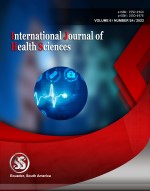Homocysteine levels in implant failure patients: an observational study
Keywords:
Homocysteine, Implant, Serum homocysteineAbstract
Background: Dental implants have been a part of our lives since 1965 when studies of Branemark commenced. Today, ever increasing number of dental implants in total or partial edentulous patients provides an outstanding treatment alternative to conventional prosthetic rehabilitation all around the world. However, widespread use of dental implants has brought alone a gradually increasing condition called “disease of peri-implant tissues”. The present study was conducted for assessing the Homocysteine levels in implant failure patients. Materials & methods: A total of 25 subjects with clinical and radiographic evidence of peri-implantitis and 25 healthy controls were enrolled. Complete demographic and clinical details of all the subjects were obtained. Fasting (minimum of 12hrs) venous blood samples were collected. The venous blood was collected in plain vials which will sent to the laboratory for biochemical analysis and evaluation of systemic parameters of both peri-implantitis group and control group. Serum homocysteine was assessed by means of Elisa Immunoassay. Results: Mean serum homocysteine levels among subjects of the control group and peri-implantitis group was 13.27 µmol/L and 25.2 µmol/L respectively. Significant results were obtained while comparing the mean serum homocysteine levels among subjects of the peri-implantitis group and control group.
Downloads
References
Konstantinidis I K, Kotsakis G A, Gerdes S, Walter M H. Cross-sectional study on the prevalence and risk indicators of peri-implant diseases. Eur J Oral Implantology. 2015;8(01):75–88.
Working Group 4 of Seventh European Workshop on Periodontology . Lang N P, Berglundh T. Periimplant diseases: where are we now?–consensus of the seventh European workshop on periodontology. J Clin Periodontol. 2011;38 11:178–181.
Mombelli A, Müller N, Cionca N. The epidemiology of peri-implantitis. Clin Oral Implants Res. 2012;23(06) 06:67–76
Ata-Ali J, Ata-Ali F, Bagan L. A Classification Proposal for Peri-Implant Mucositis and Peri-Implantitis: A Critical Update. The Open Dentistry Journal, 2015 Dec, 9, 393-395.
Ritter L, Elger MC, Rothamel D, Fienitz T, Zinser M, Schwarz F, Zöller JE. Accuracy of peri-implant bone evaluation using cone beam CT, digital intra-oral radiographs and histology. Dentomaxillofac Radiol. 2014;43(6):20130088.
Albrektsson T, Isidor F. Consensus report of session IV.; In: Lang NP, Karring T, editors. Proceedings of the 1st European workshop on periodontology. London: Quintessence Publishing; 1994. p. 365-9.
Roos-Jansåker A M. Long time follow up of implant therapy and treatment of peri-implantitis. Swed Dent J Suppl. 2007;188(188):7–66.
Serino G, Turri A, Lang N P. Probing at implants with peri-implantitis and its relation to clinical peri-implant bone loss. Clin Oral Implants Res. 2013;24(01):91–95.
Suryasa, I. W., Rodríguez-Gámez, M., & Koldoris, T. (2021). Get vaccinated when it is your turn and follow the local guidelines. International Journal of Health Sciences, 5(3), x-xv. https://doi.org/10.53730/ijhs.v5n3.2938
Marrone A, Lasserre J, Bercy P, Brecx M C. Prevalence and risk factors for peri-implant disease in Belgian adults. Clin Oral Implants Res. 2013;24(08):934–940.
Yanti, R., Sinrang, A. W., & Aminuddin, A. (2021). Levels of c-reactive protein (CRP) in stunting and non stunting tolls age 36-60 months. International Journal of Health & Medical Sciences, 4(1), 150-154. https://doi.org/10.31295/ijhms.v4n1.1667
Khichy A, Khichy R, Singh R, Bali Y, Kaur S, Gill TK. Assessment of Levels of C-Reactive Proteins and Interleukin 6 in Patients with Peri-Implantitis: A Case-Control Study. J Pharm Bioallied Sci. 2021;13(Suppl 1):S444-S447.
Ueland PM. Choline and betaine in health and disease. J Inherit Metab Dis. 2011;34(1):3–15.
Thaler R, Agsten M, Spitzer S, Paschalis EP, Karlic H, Klaushofer K, Varga F. Homocysteine suppresses the expression of the collagen cross-linker lysyl oxidase involving IL-6, Fli1, and epigenetic DNA methylation. J Biol Chem. 2011;286(7):5578–5588.
Joseph R, Nath SG, Joseraj MG. Elevated plasma homocysteine levels in chronic periodontitis: a hospital-based case-control study. J Periodontol. 2011;82(3):439–444.
Bhardwaj S, Prabhuji ML, Karthikeyan BV. Effect of non-surgical periodontal therapy on plasma homocysteine levels in Indian population with chronic periodontitis: a pilot study. J Clin Periodontol. 2015;42(3):221–227.
Published
How to Cite
Issue
Section
Copyright (c) 2022 International journal of health sciences

This work is licensed under a Creative Commons Attribution-NonCommercial-NoDerivatives 4.0 International License.
Articles published in the International Journal of Health Sciences (IJHS) are available under Creative Commons Attribution Non-Commercial No Derivatives Licence (CC BY-NC-ND 4.0). Authors retain copyright in their work and grant IJHS right of first publication under CC BY-NC-ND 4.0. Users have the right to read, download, copy, distribute, print, search, or link to the full texts of articles in this journal, and to use them for any other lawful purpose.
Articles published in IJHS can be copied, communicated and shared in their published form for non-commercial purposes provided full attribution is given to the author and the journal. Authors are able to enter into separate, additional contractual arrangements for the non-exclusive distribution of the journal's published version of the work (e.g., post it to an institutional repository or publish it in a book), with an acknowledgment of its initial publication in this journal.
This copyright notice applies to articles published in IJHS volumes 4 onwards. Please read about the copyright notices for previous volumes under Journal History.
















